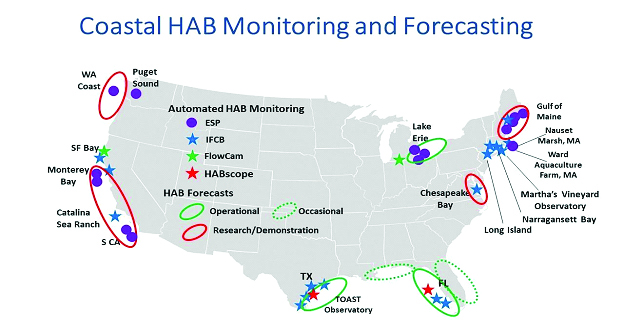The National Harmful Algal Bloom Observing Network (NHABON) Framework offers a high-level regional analysis of existing efforts to monitor and forecast harmful algal blooms (HABs) and identifies gaps in observing capabilities that can best be addressed with a national network. The framework is the product of an internal NOAA workshop hosted by NOAA’s Integrated Ocean Observing System (IOOS) and National Centers for Coastal Ocean Science (NCCOS), with representatives from five NOAA Line Offices (NESDIS, NMFS, NWS, NOS, and OAR).
Observations and measurements of HAB species and toxins are critical to support early warning, forecasting (e.g., initializing models, validating model outputs), and research on HAB growth and toxin dynamics. Many regional observing assets currently in use are funded through short-term research projects, which will lead, in the near future, to the loss of critical observing and data acquisition infrastructure used by forecasters and decision makers.

Regions with HAB monitoring and forecasting. These efforts are supported primarily with research funding. Operational forecasts are those that are consistently conducted. Occasional forecasts are those that may be conducted sporadically in response to bloom dynamics. The Environmental Sample Processor (ESP) uses molecular or antibody probes to detect HAB cells or toxins, while the Imaging FlowCytobot (IFCB), FlowCam, and HABscope are automated or semi-automated microscopes that capture images of HAB cells. Credit: NOAA.
A National HAB Observing Network (NHABON) is needed to efficiently and effectively integrate local, state, regional, and federal HAB observing capabilities and deliver products operationally. The Framework document has been used recently (December 2020) to support development of an “Implementation Strategy for a National Harmful Algal Bloom Observing Network (NHABON)”, through an effort led by the IOOS Association with input from NOAA, NGOs, and academic institutions. Implementation of the NHABON will achieve the following benefits: enable HAB forecasting and early warning; leverage economies of scale and enhance information transfer between regions; determine algal community baselines and discern trends to help assess the impacts of climate change, eutrophication, and other environmental forcings; and provide observations to support NOAA's mission of understanding and predicting changes in our oceans.
 Official websites use .gov
A .gov website belongs to an official government organization in the United States.
Official websites use .gov
A .gov website belongs to an official government organization in the United States. Secure .gov websites use HTTPS
A lock or https:// means you’ve safely connected to the .gov website. Share sensitive information only on official, secure websites.
Secure .gov websites use HTTPS
A lock or https:// means you’ve safely connected to the .gov website. Share sensitive information only on official, secure websites.